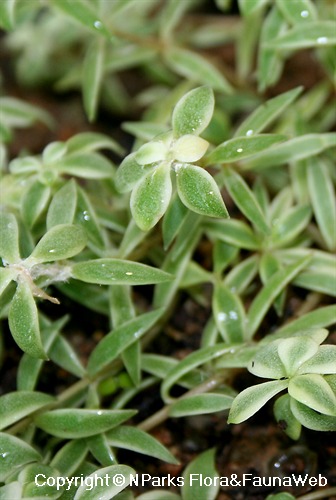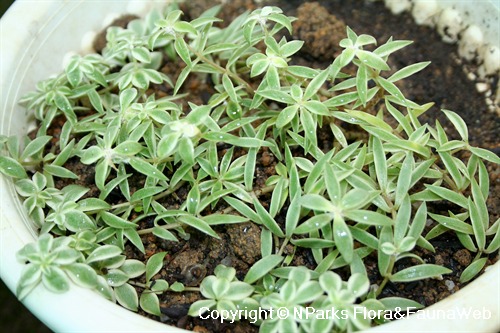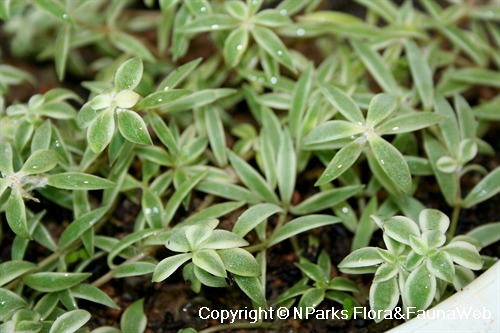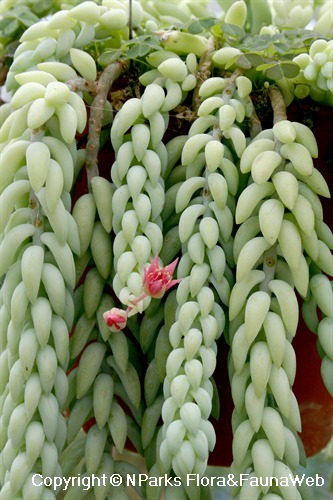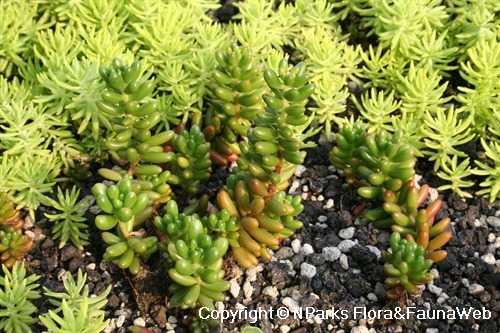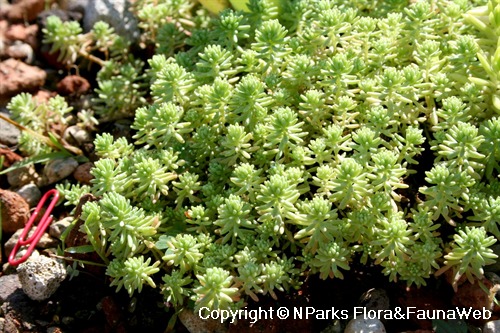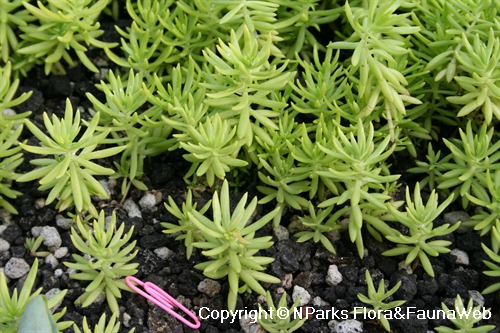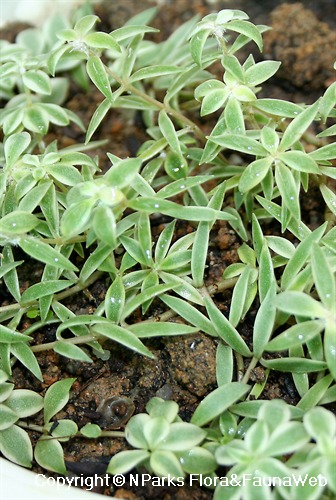
Back
Sedum lineare 'Variegatum'
| Family Name: | Crassulaceae |
| Synonyms: | Sedum lineare var. albomarginatum, Sedum lineare f. variegatum |
| Common Name: | Variegated Star Sedum, Creme & Green Carpet Sedum, Variegated Stonecrop, Variegated Carpet Sedum, 白佛甲草 |
Name
Classifications and Characteristics
| Plant Division | Angiosperms (Flowering Seed Plants) (Dicotyledon) |
|---|---|
| Plant Growth Form | Herbaceous Plant, Creeper |
| Lifespan (in Singapore) | Perennial |
| Mode of Nutrition | Autotrophic |
| Plant Shape | Dwarf |
| Maximum Height | 0.10 m to 0.15 m |
| Maximum Plant Spread / Crown Width | 0.6 m to 0.9 m |
Description and Ethnobotany
| Growth Form | Herbaceous succulent shrub, creeping to form low loose mats up to 15cm height. |
|---|---|
| Foliage | Leaves narrowly ovate, fleshy, grey-green with creamy-white margins, young leaves are more upright before descending under the weight of slightly pinkish stems. |
| Flowers | Yellow, occasionally produced in low tight cymes held slightly above foliage, not observed in Singapore. |
| Taxonomy | Plant first described by Irish naturalist Robert Lloyd Praeger (1865-1953) in the Royal Horticultural Society's 1921 publication 'An account of the genus Sedum as found in cultivation', and included in the US Garden Tours Committee's 'Cacti and Succulents: An Annotated List of Plant Cultivated in Santa Barbara' in 1930. There are a few variations of the botanical name, but Sedum lineare 'Variegatum' is listed as the accepted name in RHS's Horticultural Database and most sources. |
| Cultivation | Slow-growing. Tolerates light shade but tends to be leggy. Prefers well-drained soils. Propagate by stem cuttings or division in moist porous media. |
| Etymology | Genus epithet 'Sedum' derived from Latin word for 'sit', describing how some species of this genus attach themselves to rocks and walls. Species epithet 'lineare' means 'linear or lined', a reference to the narrow leaves of the plant. |
| Ethnobotanical Uses | Others: Leaves used to weave succulent wreaths. |
Landscaping Features
| Desirable Plant Features | Ornamental Foliage, Ornamental Flowers |
|---|---|
| Landscape Uses | Suitable for Hanging Baskets, Suitable for Rooftops, Flowerbed / Border, Container Planting |
| Thematic Landscaping | Silver Garden, Rockery / Desert Garden |
Plant Care and Propagation
| Light Preference | Full Sun, Semi-Shade |
|---|---|
| Water Preference | Little Water |
| Plant Growth Rate | Slow |
| Rootzone Tolerance | Drought Tolerant, Well-Drained Soils, Poor Infertile Soils, Shallow Media |
| Maintenance Requirements | Moderate |
| Propagation Method | Stem Cutting, Division |
Foliar
| Foliage Retention | Evergreen |
|---|---|
| Mature Foliage Colour(s) | Cream / Off-White, Green, Silver / Grey |
| Mature Foliage Texture(s) | Smooth, Thick |
| Foliar Type | Simple / Unifoliate |
| Foliar Arrangement Along Stem | Whorled |
| Foliar Shape(s) | Non-Palm Foliage (Ovate) |
| Foliar Margin | Entire |
| Foliar Apex - Tip | Acuminate |
| Typical Foliar Area | Notophyll ( 20.25cm2 - 45 cm2 ) |
| Leaf Area Index (LAI) for Green Plot Ratio | 4.5 (Shrub & Groundcover - Dicot) |
Non - Foliar and Storage
| Stem Type & Modification | Herbaceous, Runner / Stolon |
|---|---|
| Root Type | Underground (Fibrous Root) |
| Specialised Storage Organ(s) | Aboveground |
Floral (Angiosperm)
| Flower Colour(s) | Yellow / Golden |
|---|---|
| Inflorescence Type | Cyme |
| Flowering Habit | Polycarpic |
Image Repository
Others
| Master ID | 29136 |
|---|---|
| Species ID | 3445 |
| Flora Disclaimer | The information in this website has been compiled from reliable sources, such as reference works on medicinal plants. It is not a substitute for medical advice or treatment and NParks does not purport to provide any medical advice. Readers should always consult his/her physician before using or consuming a plant for medicinal purposes. |

